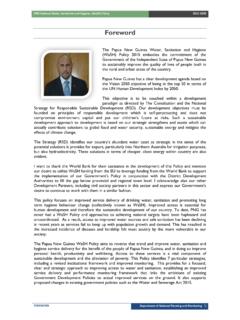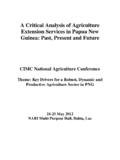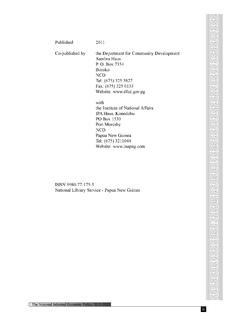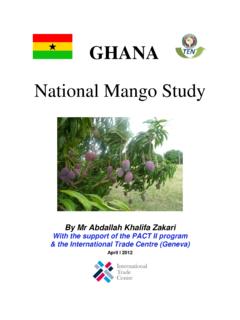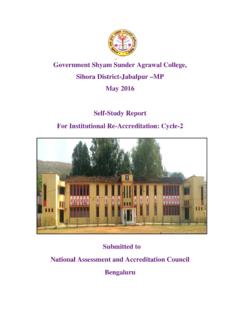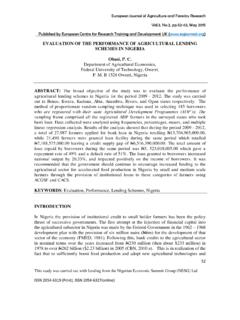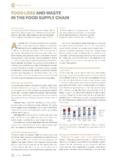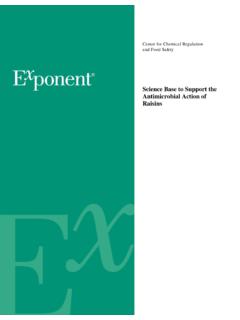Transcription of Research of Economic Growth in Papua New Guinea
1 INSTITUTE OF national AFFAIRS. Working Paper No. 17. 2007. Research of Economic Growth in Papua New Guinea Jilin Province People's Government Research and Development Centre of China Institute of national Affairs December 2007. First published December 2007. Published by: Institute of national Affairs PO Box 1530, Port Moresby NCD. Papua New Guinea Copyright 2007 Institute of national Affairs ISBN 9980-77-151-8. national Library Service Papua New Guinea Foreword: This study was undertaken in 2006 by the Jilin Province People's Government Research and Development Centre of China, as part of the INA's series on Growth Policies for After many years of low or even negative Growth during the 1990s and early 2000s PNG's GDP started to pick up in the mid-2000s, but initially only marginally above the population Growth rate.
2 PNG's Economic statistics are notoriously unreliable or unavailable, so the real population and GDP Growth rates remains at this stage uncertain. Dr Satish Chand's and Dr Ebrima Faal's paper (released by the IMF) both issued during 2007 both emphasise the need for higher and more sustainable Growth rate if PNG is to start extending opportunities (and employment) to the wider community, rather than merely the elite in urban areas and enclave Growth industries. With China's burgeoning Growth rate and as the regional boom economy, driving the recent commodity price hike and absorbing much of PNG's raw material exports, it seemed appropriate for the INA to invite a Chinese Research institute to apply their own experience and undertake a study on PNG's Economic conditions and provide their initial impressions and policy suggestions.
3 It had been intended to undertake a more detailed study, but circumstances prevented that. This paper is the outcome of an initial brief study, and it is hoped that this will merely be the start of more extensive interaction between the INA and policy institutes in China and elsewhere in East, and South Asia, complementing work undertaken with the INA's longer established partnerships with international policy Research bodies. The Institute would like to thank the Jilin Province People's Government Research and Development Centre, and notably Liu Tianjao, the Embassy of People's Republic of China (who's former Ambassador introduced the INA to the Jilin Research Centre), and to Salmah Eva-Lina Lawrence for assisting with editing the text in dialogue with Liu Tianjao.
4 Paul Barker Director, Institute of national Affairs December 2007. Research of Economic Growth in Papua New Guinea On the request of the Papua New Guinea Institute of national Affairs, the Jilin Province People's Government Research and Development Centre of China undertook Research about the state of Economic Growth of Papua New Guinea as a project of aid to foreign countries. Our findings are as follows: Papua New Guinea became independent in 1975, after finishing nearly a hundred years of colonial rule. But the Economic development is quite slow all the while; the development pattern of resources output has not obtained the speed of Economic increase in similar nations. The index of the human development is behind the level of some developing nations in Africa and Asia.
5 Nearly 40% population is living below the international poverty line, a significant portion of the population is still keeping a basic subsistence tribal life style, with the Economic Growth rate of recent years just counterbalancing the population Growth rate. It is commendable that Papua New Guinea has realized the deficiencies of the original development pattern, unduly dependent upon international aid, with the current government providing positive stable conditions for economy Growth , resulting in the state of the economy have been improving. First, we provide an analysis of the Economic development strengths and weaknesses I Strengths The natural resources are rich. Countries which possess natural resources have an automatic advantage for Economic development.
6 Papua New Guinea has 1,831. tons of gold reserves, which places it in the front row in the world; its export income accounts for of the gross export income;. land-based and seabed natural gas and prospective oil respectively is 1. thousand billion cubic feet and 400 million barrels; it possesses 1/3 of the tuna resources of the central and western Pacific Ocean, which has been an important source of income since the 1980's;. Moreover it has the third biggest remaining area of tropical rainforest in the world, about 78% land of Papua New Guinea being covered by forest. The agricultural history is impressive. 87% of the Papua New Guinean people live in the countryside, which has some of the best growing conditions for horticulture and some of the oldest traditions of cultivation in the world.
7 In the highlands area, they can plant vegetables, such as broccoli, lettuce, potato, and fruit, including fruit trees and strawberry, which normally could never be grown in the tropics and providing tourists a pleasant surprise. There are also the traditional tropical fruit, like banana, pineapple and mango and vegetables in the lowlands areas, providing tourists a feel for the exotic; there is archaeological evidence of some of the world's earliest agriculture in the highlands, which was established 9,000 years ago. The ancient breeds the modern and the traditional skills are providing a basis for innovation in Papua New Guinea now, with its traditional agriculture supplying food for own use gradually adjusting towards sale of produce to the urban market, including the tourist market.
8 Tourists not only appreciate the natural beauty of this tropical paradise, but also the exotic taste of its diverse foods. Tourism potential is huge. Most of rural Papua New Guinea remains untouched by modern industry; the pristine natural beauty is an attraction for travellers. As a result of geographical structural change 25 million years ago, Papua New Guinea not only possesses rich mineral, petroleum and natural gas resources, but also has archaeological and geological landscapes . grand sierras and majestic canyons. Moreover, evidence of some of the earliest agricultural people on earth is found in Papua New Guinea . 2. Human settlement dates back more than 45,000 years. Cultivation of taro, Chinese yam, banana, sugar cane, cowpea and other plants dates back 9,000 years.
9 At the same time, there is a multi-cultural diversity from the myriad of tribes and ethnic groups. At present, annual tourism income is about 20 million US dollars, with the majority of tourists coming from Australia and Canada. With government support and encouragement Papua New Guinea 's unique tourism potential can be leveraged. II Weaknesses Economic output is low and its increase is slow. In 2005, the GDP of Papua New Guinea was 3,924 million US. dollars, accounting for of global GDP, of Asia and of the Pacific Ocean area. It was 133rd in 179 countries surveyed by the World Bank; Average GDP per person was 660 US dollars, ranked 132nd; GDP Growth achieved , which surpassed population Growth for the first time. 3.
10 Real GDP Increase From1995-2009. 8. 6. 4. % Growth 2. 0. -2. -4. -6. 1995 1996 1997 1998 1999 2000 2001 2002 2003 2004 2005 2006 2007 2008 2009. rev rev Year GDP non-mine GDPincrease population increase Industrial structure is simple; products attachment value is low. At present, the Papua New Guinea agriculture and the minerals industry output value generate 62% of GDP (see next table for details). Papua New Guinea receives very few profits and most nationals receive only a small income because the main resources and enterprises are concentrated in foreign ownership, primarily from Australia and the US. The Papua New Guinea economy will be greatly affected when the market or capital investment changes even slightly.
